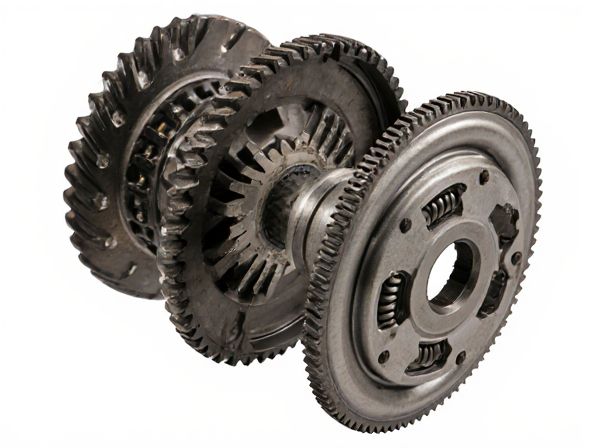
Photo illustration: Helical Gear vs Clutch Pack
Helical gears provide smooth, quiet power transmission with angled teeth that engage gradually, making them ideal for continuous torque transfer in applications like gearboxes and automotive differentials. Clutch packs consist of multiple friction discs that engage or disengage to control power flow, offering precise torque modulation and rapid shifts in performance-focused machinery such as motorcycles or automatic transmissions. Understanding the differences between helical gears and clutch packs can help you select the right component for efficient power delivery and vehicle control.
Table of Comparison
| Feature | Helical Gear Differential | Clutch Pack Differential |
|---|---|---|
| Operation | Uses angled helical gears for smooth torque transfer | Employs multiple clutch plates to control wheel spin |
| Traction Control | Provides limited slip by torque biasing through gears | Offers adjustable and variable locking through clutch engagement |
| Durability | High durability with minimal wear under standard use | Clutch plates may wear faster, requiring maintenance |
| Performance | Smooth, quiet operation ideal for everyday driving | Better for aggressive driving with rapid traction adjustments |
| Maintenance | Low maintenance due to robust gear design | Requires periodic inspection and replacement of clutch plates |
| Cost | Generally lower initial cost and repair expenses | Higher cost due to complex clutch components and maintenance |
Introduction to Helical Gears and Clutch Packs
Helical gears feature angled teeth that engage gradually, providing smoother and quieter transmission of power compared to straight-cut gears. Clutch packs consist of multiple friction discs or plates designed to engage or disengage power flow in transmissions, allowing for controlled torque transfer and efficient energy management. Both components are critical in automotive and industrial machinery, optimizing performance and durability in complex mechanical systems.
Basic Working Principles
Helical gears transmit power through angled teeth that engage gradually, providing smooth and quiet torque transfer between shafts. Clutch packs operate by compressing multiple friction plates to engage or disengage power flow selectively, enabling controlled torque transmission and slipping capabilities. Helical gears are mechanical linkages for continuous power transfer, while clutch packs facilitate intermittent engagement in automotive or industrial drivetrains.
Key Differences in Design
Helical gears feature angled teeth that provide smoother and quieter power transmission with gradual tooth engagement, while clutch packs consist of multiple friction plates designed to engage or disengage power transfer through frictional force. Helical gears are primarily mechanical components for continuous rotational motion, whereas clutch packs serve as controllable connectors in transmission systems allowing selective power flow. The design of helical gears emphasizes load distribution and durability, contrasting with clutch packs that prioritize friction material and actuation mechanisms for efficient torque modulation.
Efficiency and Performance Comparison
Helical gears provide high efficiency and smooth power transmission due to their angled teeth, which reduce noise and vibration compared to straight-cut gears. Clutch packs offer variable engagement, enabling controlled slip and torque transfer, which enhances performance in applications requiring adjustable power delivery. In terms of efficiency, helical gears typically outperform clutch packs because they have less energy loss during continuous operation, while clutch packs excel in performance flexibility and torque modulation.
Applications in Automotive and Machinery
Helical gears are widely used in automotive transmissions, differential systems, and industrial machinery for their smooth operation and ability to handle high torque loads with reduced noise and vibration. Clutch packs are essential in automatic transmissions, heavy machinery, and off-road vehicles, providing precise torque transfer and enabling smooth gear shifts under varying load conditions. Both components play critical roles in powertrain efficiency, with helical gears optimizing rotational motion and clutch packs managing engagement and disengagement of drive elements.
Durability and Maintenance Considerations
Helical gears exhibit superior durability due to their angled teeth design, which enables smoother engagement and distributes load evenly, reducing wear over time. Clutch packs, while effective for torque transmission, often require frequent maintenance because friction materials degrade faster under stress compared to the hardened steel in helical gears. Maintenance of helical gears primarily involves lubrication checks to prevent wear, whereas clutch packs demand regular inspection and replacement of friction plates to ensure optimal performance.
Noise and Smoothness of Operation
Helical gears generate less noise and vibration due to their angled teeth, which engage gradually, providing smoother and quieter operation compared to straight-cut gears. Clutch packs, while enabling smooth power transfer, can produce noise from friction surfaces and wear over time, potentially compromising overall quietness. The continuous meshing of helical gears ensures consistent smoothness, whereas clutch packs rely on precise engagement control to minimize operational noise.
Cost Analysis: Helical Gear vs Clutch Pack
Helical gears generally incur higher initial manufacturing costs due to precision machining and material requirements, but offer long-term durability and lower maintenance expenses. Clutch packs present lower upfront costs and simpler production processes, yet may experience increased wear and higher replacement frequency, raising overall lifecycle expenses. Evaluating total cost of ownership, helical gears tend to be more cost-effective in heavy-duty applications, while clutch packs suit budget-sensitive, less demanding environments.
Pros and Cons of Each System
Helical gears provide smooth and quiet power transmission with high load capacity and efficiency, making them ideal for continuous, heavy-duty applications, but they can generate axial thrust and require precise alignment. Clutch packs offer flexible torque transfer and easy engagement control, excelling in applications demanding variable power modulation, although they may suffer from wear over time and reduced efficiency due to friction losses. Choosing between helical gears and clutch packs depends on factors like load type, control complexity, durability requirements, and maintenance preferences.
Choosing the Right System for Your Needs
Helical gears offer smooth, quiet operation and high load capacity, making them ideal for applications requiring continuous power transmission and durability. Clutch packs provide controlled engagement and disengagement, enabling effective torque modulation and better performance in systems needing variable power delivery. Choosing the right system depends on whether the priority is consistent, efficient power transfer or precise control over torque and speed.
 caratoz.com
caratoz.com